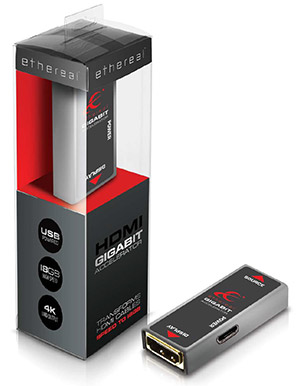
Part 4 of 6 - Construction of a HDMI Cable: Silver Content
Tuesday, October 13, 2015 8:22:00 PM America/New_York
Now we are starting to get into the more esoteric physics of an HDMI® cable. For many years, mainstream analog audio cable manufacturers talked about “Skin Effect” and how higher frequency’s tend to migrate to the surface of a cable and that lower frequencies stayed in the middle. As it turns out, there is some truth to this statement. Oh, not in the analog audio domain, that is still BS (in our opinion). However, in the high speed world of HDMI surface silver content and the type of dielectric do play a part in the performance of a HDMI cable. Now just throwing a thicker cost of silver onto the copper is not the complete answer. There must be a proper balance. Copper provides a stable high tinsel substrate for the silver plating, this will help the wire to keep its original length and shape which is necessary for the higher bandwidth and speeds (see #1 & #3).
Part 5 of 6 - Construction of a HDMI Cable: Termination
Tuesday, October 20, 2015 8:17:23 PM America/New_York
In the previous installments of this series, we have discussed everything needed for the best performing HDMI® cable and to improve overall performance in a system. With that being said without the proper termination quality parts will mean nothing and the cable will not provide top performance.
It is very important to control the heat, silver content, quantity and flow of the solder. Less is more in this application and of course “Cleanliness is next to Godliness”. Extra solder closes the gaps between the connection points and that can/will create its own RF field. To add insult to injury, when it comes to the soldering process ROHS (Federal Lead standards) has mandated that lead be mostly removed from solder for safety reason. Unfortunately this means that solder most be applied at a higher temperature for it to flow. Higher temps mean a greater chance of thermal damage to any board level components.
Part 6 of 6 - Construction of a HDMI Cable: Testing Procedures
Tuesday, October 27, 2015 7:59:41 PM America/New_York
If you have made it this far in the series you have seen how important each part of the cable is at least in our option. The real question is, how can this be validated as truth and not just be set aside as the ramblings of a PR/Marketing department?
Let us return for a moment to a contributing factor in what triggered this series, Still More Reasons Why All HDMI® Cable Are The Same and "4K HDMI Cables Are Nonsense". The issue here for us is the testing methodology, all that was done to verify the quality of a given cable was (A) borrow a tone generator/scope and sweep/Eye pattern test one channel at a time of the three video channels and (B) plug the cables in between a source and a display. This is not a good or accurate way to test as timing of the 3 channels together is critical and without this concurrent channel testing results will be skewed.
So, how can you know if a cable is worth a damn? DPL testing that’s how.
CEDIA 2015 Wrap Up
Thursday, October 29, 2015 7:51:17 PM America/New_York
In the craziness of returning from Dallas last week - this post was not posted on the blog. We apologize.
Whew! What a whirlwind CEDIA 2105 was in Dallas. It was the best show Metra Home has had to date and it is largely due to the combination of great products and staff. Seriously, our staff is the hardest working staff I know and no other company can touch our products. My co-workers are a great group of people. As I sat in the front desk during the show, I overheard things being said by staff and attendees and I made up a list:

- WOW nice booth!
- My feet hurt.
- Don’t lean on the front desk.
- Who left coffee on the front desk
- Where is my coffee?
- My feet hurt.
- You sure that is the correct price?
- Are you seriously taking an order on a trashcan?
- I have not eaten all day
- My feet hurt.
Why You Need Our HDM-GA1
Tuesday, November 3, 2015 8:40:35 PM America/New_York

In previous posts, we discussed our HDM-GA1 and the three awards it won during CEDIA 2015 in Dallas. Awards are great but if our customers do not understand WHY this product is winning awards, then Metra Home is not educating our customers. Education is key to staying on top of the CI game and here at Metra Home we want to be the go-to resource for CI questions.
We made our name in the early days of HDMI® by providing the first “Made in America” long distance HDMI cable solution, and we have continued to develop and refine these capability with our latest (and still) “Made in America” extender the HDM-GA1.
4K and HDR are real, products will be shipping this Christmas and in the hands of your clients by the first of the year. How will this affect you and more importantly how do you plan your installs to accommodate this expanded bandwidth requirement?
Well… if your jobs are based around category cable extenders or current Redmere enabled cables, you will be in a world of hurt as neither of these technologies truly support 4K/60 4:4:4 or HDR content. If instead you use the older style passive HDMI cables (up to 15 meters in length) you can take your jobs forward and include ANY capability that HDMI 2.0A by using our HDM-GA1.











